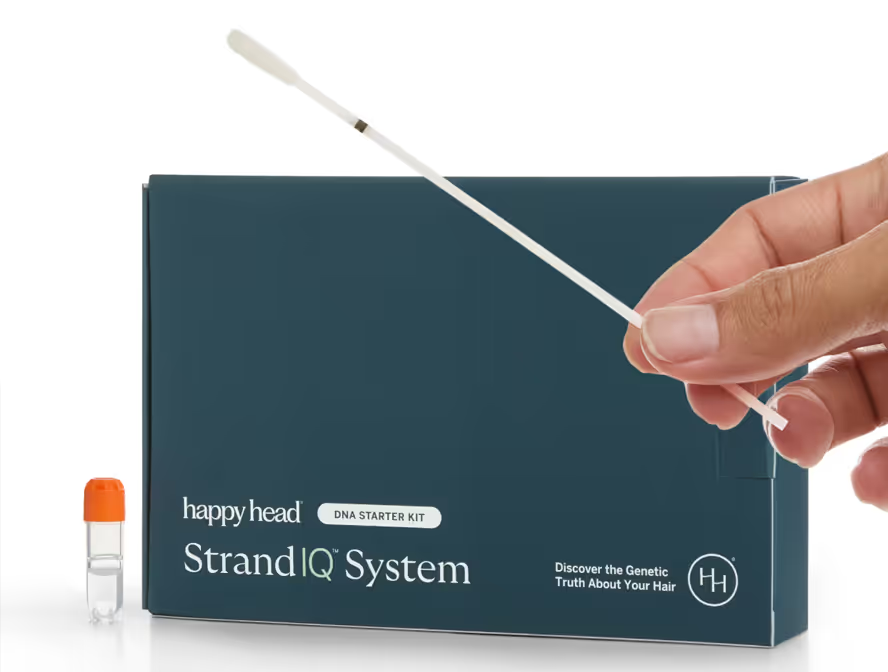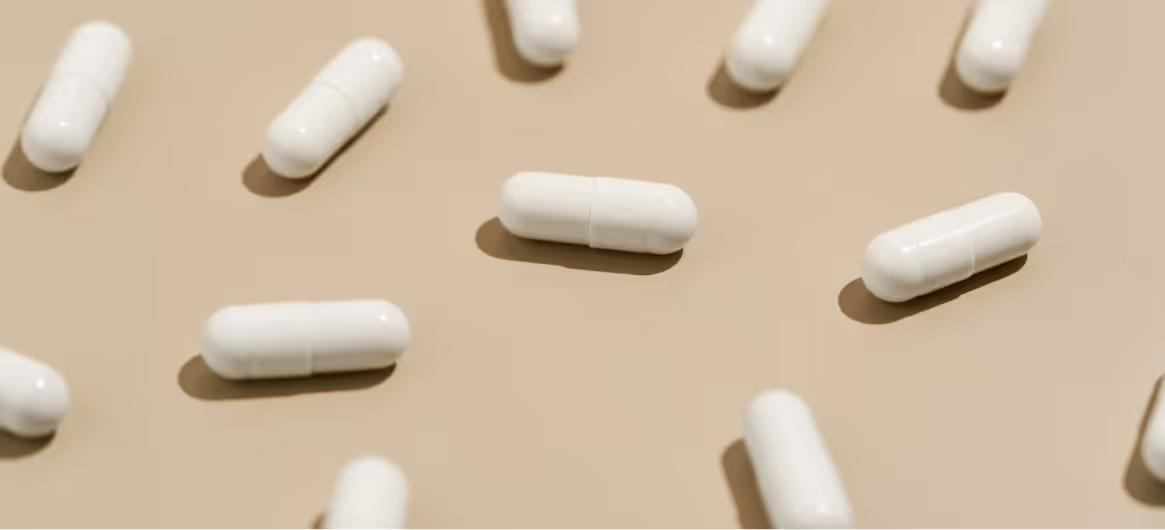Iron is one of the most important minerals for hair growth—and one of the most overlooked. It supports hemoglobin production, which carries oxygen to rapidly dividing follicle cells. These cells fuel the anagen (active growth) phase of the hair cycle.
When iron is lacking, follicles can’t get enough oxygen to sustain their energy demands. Over time, this can lead to:
- diffuse thinning across the scalp
- excessive shedding after illness, childbirth, or high stress
- slower regrowth following hair loss events
- increased hair fragility and lack of density
For many, low ferritin (the storage form of iron) is a hidden contributor to hair loss—especially in women. Even if hemoglobin levels are within normal range, suboptimal ferritin can still impair follicle health.
The Role Genetics Play in Iron Processing
Your body’s ability to absorb, store, and use iron is heavily influenced by genetics. Even a nutrient-rich diet may not prevent iron deficiency if genetic variants reduce efficiency at key stages.
Important genetic factors include:
- HFE gene variants – These regulate iron absorption from the intestine. While certain mutations can lead to iron overload, others are linked to suboptimal absorption, particularly in menstruating women.
- TMPRSS6 variants – This gene influences hepcidin production, the hormone that controls iron absorption and release. Overproduction of hepcidin can block efficient iron uptake.
- Transferrin receptor (TFRC) variants – These affect how iron is transported from the blood into cells, including those in the hair follicle.
- Ferritin-related gene variants – These influence how much iron your body stores and how readily it releases it for use.
If you carry variants in these pathways, you may be more prone to low ferritin and functional iron deficiency, even when your diet appears sufficient.
Recommendations Based on Genetic Risk
The following strategies can help optimize iron intake and usage at different levels of Happy Head StrandIQ-identified genetic susceptibility.
Low Risk: Maintain Balanced Iron Levels
If your genetic profile shows low risk, your focus should be on maintaining steady iron intake and absorption.
- Eat plant and animal sources
Beef, poultry, liver, oysters, salmon, and tuna are excellent sources of heme iron, which is easier for the body to absorb. Plant-based sources include beans, lentils, fortified cereals, and dark leafy greens like spinach and kale. - Boost plant iron with vitamin C
Pair iron-rich vegetables or grains with citrus fruits, strawberries, bell peppers, or tomatoes to improve absorption. - Avoid inhibitors during meals
Tea, coffee, and high-calcium foods like dairy can reduce iron absorption when consumed with iron-rich meals.
Medium Risk: Optimize Absorption and Reduce Losses
If your StrandIQ analysis identified you as being at moderate genetic risk for weak iron processing, you may need to be more strategic about when and how you consume iron.
- Time your calcium and caffeine
Consume dairy, coffee, and tea at least one to two hours away from iron-rich meals to maximize absorption. - Watch for hidden losses
Heavy menstruation, frequent blood donation, or high-intensity endurance exercise can all lower iron stores more quickly. - Seek professional input
If low ferritin is detected, your Happy Head provider may recommend an iron supplement tailored to your needs.
High Risk: Combine Nutritional, Medical, and Lifestyle Strategies
If you have high genetic susceptibility, your iron regulation may require ongoing attention to prevent chronic deficiency.
- Daily intake of heme iron sources
Incorporate foods like beef, poultry, organ meats, shellfish, and oily fish like salmon or sardines into your daily diet. - Vegan or vegetarian adaptations
Use iron-rich foods such as tofu, tempeh, fortified cereals, quinoa, lentils, and pumpkin seeds. Always pair with vitamin C to enhance bioavailability. - Monitor medication interactions
Some antibiotics, antacids, and thyroid medications can interfere with iron absorption—consult your doctor if you take these regularly. - Professional testing and supplementation
Work with your physician to monitor ferritin and iron saturation levels. If supplementation is prescribed, use the form and dosage recommended to avoid gastrointestinal side effects or iron overload.
The Connection Between Iron Deficiency and Hair Loss
Research consistently shows that low ferritin levels are linked to hair shedding, particularly in women with chronic telogen effluvium (CTE). Iron deficiency disrupts the hair cycle by shortening the anagen phase, meaning more follicles enter the shedding (telogen) phase prematurely.
Correcting iron deficiency—whether through diet, supplements, or both—can significantly improve shedding and regrowth timelines, though hair recovery may take several months.
Taking a Proactive Approach
Iron is a foundational nutrient for healthy, resilient hair. While diet plays a major role, genetic variations can influence how efficiently you absorb, store, and transport iron. Knowing your genetic profile allows you to make informed decisions about diet, lifestyle, and monitoring strategies.
For those with higher risk, early testing and intervention can prevent long-term hair density loss and support optimal scalp health. Regardless of your risk category, consistently combining iron-rich foods with absorption-friendly practices will benefit both your hair and overall health.
Resources
StrandIQ SNP Marker Count: 21
StrandIQ Genes for Trait:
ABO, ACSL3P1, ACTL6B, BMAL1, BTN1A1, CNGB3, DUOX2, F5, GOLGA2P1, H2BC4, HFE, INHCAP, KCTD17, LARRPM, MAD1L1, RAB6B, SLC17A2, SRPRB, TF, TFR2, TMPRSS6
References:
Beben, B., et al. (2009). Variants in TF and HFE explain approximately 40% of genetic variation in serum-transferrin levels. American Journal of Human Genetics, 84(1), 60–65. PMID: 19084217.
Benyamin, B., et al. (2014). Novel loci affecting iron homeostasis and their effects in individuals at risk for hemochromatosis. Nature Communications, 5, 4926. PMID: 25352340.
Buerkli, S., et al. (2021). The TMPRSS6 variant (SNP rs855791) affects iron metabolism and oral iron absorption – a stable iron isotope study in Taiwanese women. Haematologica, 106(11), 2897–2905. PMID: 33054130.
Chambers, J.C., et al. (2009). Genome-wide association study identifies variants in TMPRSS6 associated with hemoglobin levels. Nature Genetics, 41(11), 1170–1172. PMID: 19820698.
Guindo-Martínez, M., et al. (2021). The impact of non-additive genetic associations on age-related complex diseases. Nature Communications, 12(1), 2436. PMID: 33893285.
Li, J., et al. (2015). Genome-wide admixture and association study of serum iron, ferritin, transferrin saturation and total iron binding capacity in African Americans. Human Molecular Genetics, 24(2), 572–581. PMID: 25224454.
McLaren, C.E., et al. (2011). Genome-wide association study identifies genetic loci associated with iron deficiency. PLoS One, 6(3), e17390. PMID: 21483845.
Toivonen, J., et al. (2024). The value of genetic data from 665,460 individuals in managing iron deficiency anaemia and suitability to donate blood. Vox Sanguinis, 119(1), 34–42. PMID: 38018286.
Traglia, M., et al. (2011). Association of HFE and TMPRSS6 genetic variants with iron and erythrocyte parameters is only in part dependent on serum hepcidin concentrations. Journal of Medical Genetics, 48(9), 629–634. PMID: 21785125.
Yang, Z., et al. (2024). Causal relationship of serum micronutrient with autoimmune neurological diseases: a Mendelian randomization study. Preprint, Research Square. https://doi.org/10.21203/rs.3.rs-4590504/v1
This content, including StrandIQ™ DNA analysis reports and any Happy Head products and/or services referenced therein, is for informational and cosmetic purposes only. It is not intended to diagnose, treat, cure, or prevent any disease. This content does not constitute medical advice and should not be used to make healthcare decisions. References to prescription treatments are educational in nature. Always consult a licensed healthcare professional for any medical concerns or treatment decisions.








.avif)

